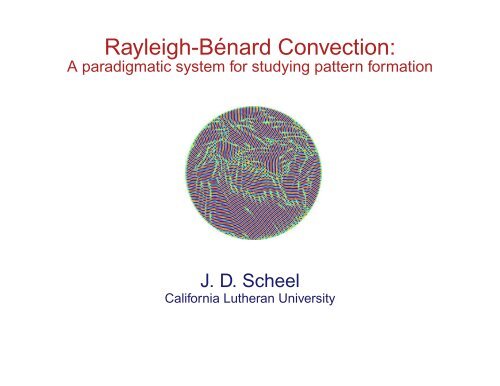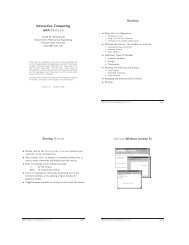Rayleigh-Benard Convection
Rayleigh-Benard Convection
Rayleigh-Benard Convection
You also want an ePaper? Increase the reach of your titles
YUMPU automatically turns print PDFs into web optimized ePapers that Google loves.
What is pattern formation?• Many “real” systems are nonequilibrium, due to driving or dissipation• Many nonequilibrium systems tend to form patterns• Examples from nature:– Snowflakesphoto courtesy ofSnowCrystals.com
What is pattern formation?• Many “real” systems are nonequilibrium, due to driving or dissipation• Many nonequilibrium systems tend to form patterns• Examples from nature:– Snowflakes– Cloud patterns– Mammalian coat patterns
Examples from the laboratory• Belousov-Zhabotinsky reactionsphoto courtesy of D. Peter Ruoff
Examples from the laboratory• Belousov-Zhabotinsky reactions• Granular crispation experimentsphoto courtesy of Dr. P. Umbanhower
Examples from the laboratory• Belousov-Zhabotinsky reactions• Granular crispation experiments• Electroconvectionphoto courtesy of Dr. M. Dennin
<strong>Rayleigh</strong>-Bénard <strong>Convection</strong>TgSide ViewdT + ∆ TOverhead View
<strong>Rayleigh</strong>-Bénard <strong>Convection</strong>photos courtesy Dr. G. Ahlers
Goal of Pattern Formation• Determine if diverse patterns can be understood using reducedequations based on the underlying symmetries.
Stability DiagramFor <strong>Rayleigh</strong>-Bénard <strong>Convection</strong>Temperature Differencespiralchaosstripes(convection)domainchaosno pattern(conduction)Rotation RateSpatiotemporal chaos: chaotic in space and time
Transition to Domain ChaosA debate between experiment and theory• Theory predicts scaling laws near threshold (Tu and Cross PRL, (1992))– How do quantities scale with the control parameter ɛ ?ɛ = constant × (∆T − ∆T c )∗ precession frequency should scale as ɛ 1.0• Experimenters find (Hu, Ecke and Ahlers, PRL, (1995))– Fits to much smaller power laws∗ precesssion frequency should scale as ɛ 0.6• Finite size effects may account for discrepancy(Cross, Louie, Meiron, PRE, (2001))
Domain ChaosSupercomputer solutions of fluid equations with rotation (Coriolis force)Start with Periodic system
Domain chaosSupercomputer solutions of fluid equations with rotation (Coriolis force)Stronger driving (increase ɛ)
Domain chaosParameters are exactly the same as for the experimentsAdd rigid boundaries
Results for scaling laws: Precession frequency fslope = 0.5810 −1 εf(rad/τ ν)10 −2slope = 0.63slope = 1.15Becker,Scheel,PRE, 7310 −310 −2 10 −1F Cor+F centF CorexperimentTheory (Coriolis only) predicts slope = 1
Centrifugal Force cannot be neglected• Scaling laws agree better with experiments• Gives rise to new hybrid state for larger aspect ratioɛ = 0.05,Ω = 16.25,Γ = 80,σ = 0.8210 π
ResultsScaling of defect velocities agrees well with theorywhich predicts V glide scales as ɛ 0.75F CorF Cor, periodicslope=0.71v glide10 0 ε10 −1slope=0.7510 −3 10 −2 10 −1Scheel and Cross, PRE, 72
Other work-Lyapunov Exponents• Chaos exhibits the “Butterfly Effect”—sensitivity to Initial Conditions• “Does the Flap of a Butterfly’s Wings in Brazil set off a Tornado inTexas?” —Lorenz, 1972• Lyapunov Exponent λ is a measure of this sensitivity to initialconditions: δu(t) = δu(0)e λt• Positive Lyapunov Exponent → exponential divergence of nearbytrajectories δu(0) → system is chaotic→
ChaosSystem is truly chaotic in the sense of a positive Lyapunov exponentδu = separation of two initially nearby trajectories, t = time10 30 λ = slope =0.078t10 20δ u10 1010 0200 400 600 800Jayaraman, Scheel, Greenside and Fischer, PRE, 74
Visualization of temperature fieldcolor density plotNo rotation, smaller cell
Visualization of temperature fieldcontour plotNo rotation, smaller cell
Visualization of temperature perturbation fieldSee spiking in perturbation field during dynamical eventsNo rotation, smaller cellScheel and Cross,accepted by PRE
Conculsions• The theoretical treatment of scaling laws for the transition to theDomain chaos state needs to incorporate the centrifugal force if itis to accurately model the experimental systems• The domain chaos state of rotating <strong>Rayleigh</strong>-Bénard convection ischaotic in the sense of having a positive Lyapunov exponent
Future work• Short Term– Incorporate centrifugal force into theoretical formalism– Compute all positive Lyapunov exponents, if this scales withsystem size—gives rigorous definition of spatiotemporal chaos• Longer Term– Continue to study <strong>Rayleigh</strong>-Bénard <strong>Convection</strong>– Apply dynamical systems approach to other fluid systems such asmicrofluidics and cardiovascular dynamics.
Results for scaling laws: Correlation Length ξ1510slope = −0.23slope = −0.39ξ5F Cor+F centF Corexperimentslope = −0.2810 −2 10 −1ε















